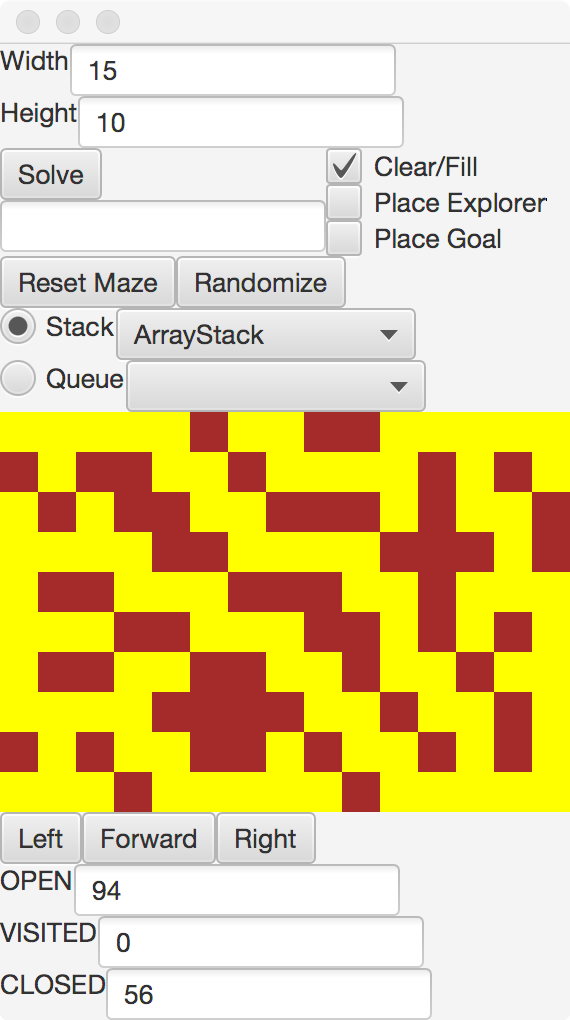CSCI 151 Lab 8: Generic Stacks and Queues (with mazes!)
Overview
In this lab, we will implement generic versions of theStack and Queue data types within the
context of solving mazes.
Setup
- Download the skeleton for this project.
- Unpack the code into a new Eclipse Java project.
Description
When searching a maze for a path to the exit, we need a way to organize the potential paths we have not yet explored. When visiting a new cell, we take all the potential exits from the cell which we have not yet visited and add them to some data structure. We then pick an unvisited cell from this data structure as the next cell to search, and repeat the process. Both stacks and queues work well as this data structure. If we use a stack, we search the maze in a depth-first manner: we explore down a trail as far as possible, and backtrack only if we reach a dead end, because we always search the youngest potential trail next.On the other hand, using a queue results in a breadth-first search of the maze, where the oldest potential trail is always expanded next.
In this lab, you will create the necessary data structures to search a maze with either depth-first or breadth-first search.
To start, run the code in MazeApp. After you
click on "Randomize", you should see a GUI layout like this:

There are a few new pieces to this GUI. First, you will see a
way for you to select a search strategy, either a Stack or a
Queue. For each strategy, you will see a list of implementations
available. To start, you will find the code for the
ArrayStack<E> included in the maze.models.searchers
directory.
Second, you will notice that there are statistics in the lower portion of the GUI, recording the number of cells that are open (i.e. in the data structure waiting to be searched), visited (i.e. on the current path), or closed (i.e. lead to a dead end).
Third, there is an error box underneath the Solve button, to report when things go wrong with the underlying implementations. It will also report the number of steps taken when a solution trail is found through searching.
Step 1 - ListNode<E>
To implement the generic version of aStack
and Queue with nodes, your first task is to reimplement
the Node class to be generic. All of your implementations for this lab
should be located in the maze.models.searchers directory.
Step 1.1 - Implementation
You will first need to create a class calledListNode that implements a generic
singly-linked node. You should be able to copy your implementation
of ListIntNode from Lab 5, and modify it to be
generic. It should have an E value and
a ListNode next reference as components, along with
getter and setter methods for the value
and next fields.
Step 2 - ListStack<E>
We will next revise your earlierListIntStack code to be generic.
Step 2.1 - Implementation
Write a class calledListStack<E>. This will
need to implement the Stack<E> interface, and have at least a
ListNode<E> called top as a field.
Note that there is an additional method to
implement, capacity. For implementations based
on ListNode, the capacity method should just
return the size.
Step 2.2 - Testing
Run theListStackTest
test suite, and ensure your above methods are passing these tests.
Step 2.3 - GUI
Now, run theMazeApp class,
and test out your code with the GUI. You should be able to select
between the ArrayStack and ListStack implementations.
Step 3 - ListQueue<E>
Now that you are comfortable with generic implementations and the maze framework, implement aQueue using the
ListNode<E> from Step 1, as discussed in class.
Step 3.1 - Implementation
Your implementation will have two fields as discussed in class,front and back (also sometimes
called head and tail). Create a new
generic ListQueue class implementing
the Queue<E> interface and completing all of the
necessary methods.
Step 3.2 - Testing
Test your code with theListQueueTest suite.
Step 3.3 - GUI
Run the GUI to try solving mazes with yourListQueue.
Step 4 - ArrayQueue<E>
Finally, you will implement a queue using a circular array-based implementation.Step 4.1 - Implementation
As discussed in class, your implementation should have three fields:- A
frontindex size- An array of
Objects (which will actually store objects of classE). You should not use anArrayList, since we need to explicitly manage the storage and keep track of used/unused elements ourselves.
ArrayQueue class implementing
the Queue<E> interface and completing all of the
necessary methods.
Your code needs to be efficient in terms of the space used. You should treat your array of elements as a circular array, and only resize the array when all positions are full of valid elements in the queue.
The capacity() method should return the length of the array
used to store the elements.
Step 4.2 - Testing
Verify that yourArrayQueue is working with the ArrayQueueTest suite.
Step 4.3 - GUI
Run the GUI to interact with your code.Step 5 - Evaluation
Create 10 mazes of size 30x30 and for each maze and strategy (Stack and
Queue), record the number of visited nodes as a
percentage of the total number of open spaces in the initial maze. You
can choose either implementation for each data type.
Use this data to compare the Stack (depth-first)
versus Queue (breadth-first) search strategies. Does
either strategy have any clear strengths or weaknesses?
What to Hand In
Submit yourListNode.java, ListStack.java, ListQueue.java
and ArrayQueue.java implementations, along with a
document for your evaluation in Step 5.
Grading
- To earn a D, finish Step 1.
- To earn a C, finish the above and Step 2.
- To earn a B, finish the above and Step 3.
- To earn a A, finish the above and Step 4.
- To earn a 100, finish the above and Step 5.
© Mark Goadrich, Hendrix College